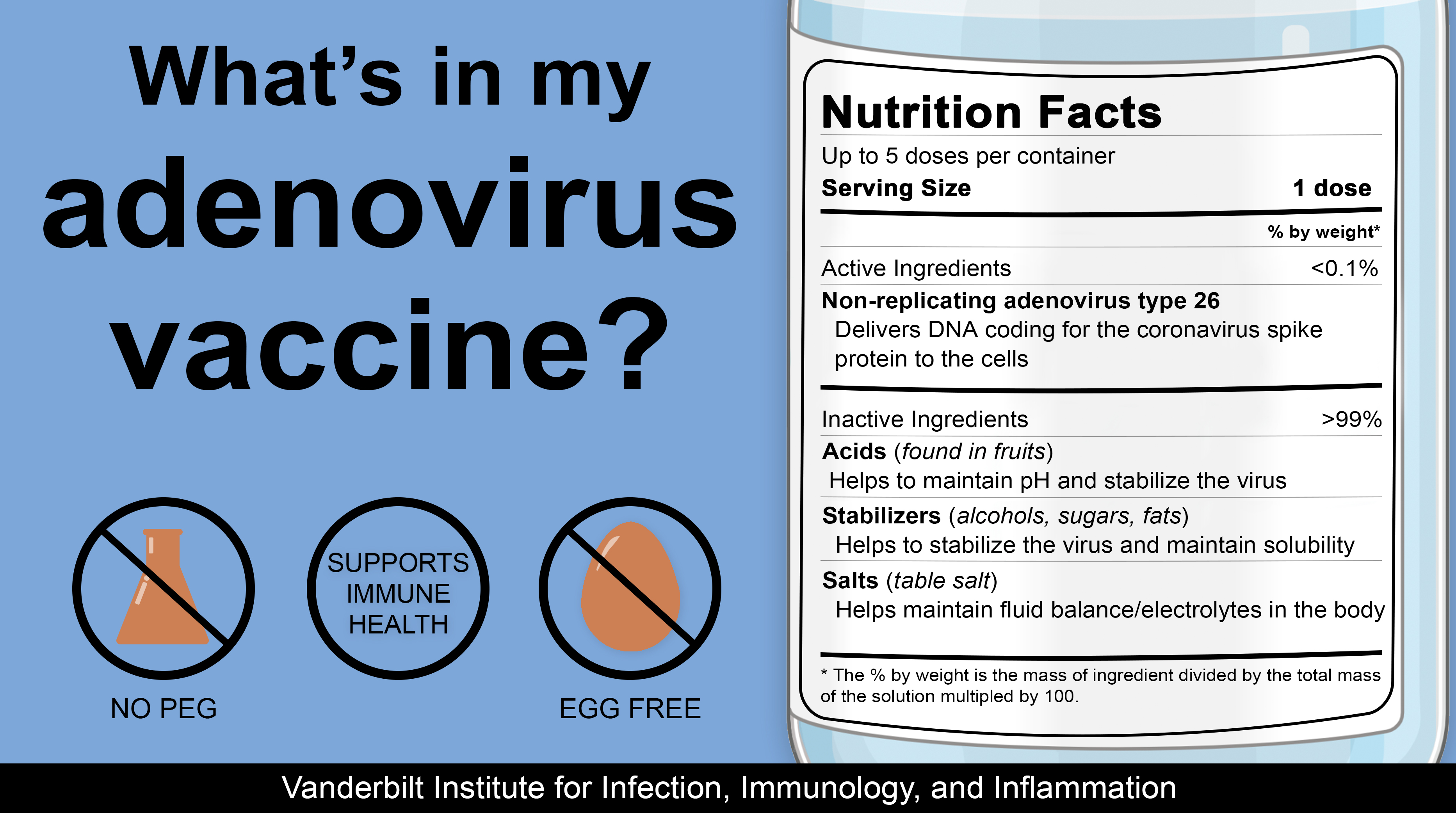
To share on Twitter click the button below or credit @VI4research!
Sharing elsewhere? Credit this page.
What's in my Adenovirus Vaccine?
The adenovirus-based vaccine is a type of vaccine that uses a surrogate virus instead of the actual coronavirus to deliver the components needed to induce an immune response. When the adenovirus infects your cells, it will release DNA coding that your cells can use to produce the spike protein. The spike protein – a harmless piece of the coronavirus – will train your immune response to protect you from getting infected/sick if you later encounter the actual virus. In addition to adding the coronavirus DNA, scientists also remove portions of the adenovirus essential for replication; thus, each virus can only infect one cell and cannot make copies of itself. Engineering the adenovirus further enhances the safety of the vaccine.
The three primary COVID-19 vaccines based on adenovirus technology are Johnson & Johnson, AstraZeneca/Oxford, and Sputnik V. Here is a list of the ingredients for the Johnson & Johnson vaccine currently available in the US.
Active Ingredient
The only active ingredient is the replication-incompetent recombinant adenovirus type 26 (Ad26). While Ad26 can cause mild cold-like symptoms in humans, the virus has been modified to not spread throughout the body and cause illness.
To produce the virus in large quantities, Johnson & Johnson uses PER.C6 cells. The cell line was originally derived from the retinal cells of a human embryo in the 1980s and has been engineered to be grown indefinitely and used for industrial production of vaccines. However, the virus is purified from the cells during the manufacturing process, so no cells remain in the vaccine preparation. Therefore, claims that this vaccine contains fetal cells or human tissues are false.
Inactive Ingredients (99.7-99.8%)
There are three main types of inactive ingredients in this vaccine: buffers, stabilizers/emulsifiers, and salt. These make up the rest of the vaccine and help to maintain the stability of the adenovirus.
Buffers are composed of acids that normalize the pH of the vaccine, so it matches the pH in our bodies. The buffers included in the COVID-19 vaccine are:
Citric acid monohydrate, an acid that is found in many fruits and vegetables
Trisodium citrate dihydrate, an acid commonly added to many foods and drinks (including club soda and bratwurst) that contributes to the tart flavor
Stabilizers/emulsifiers are solutions that help maintain the stability of and solubilize the virus. Examples of the stabilizers in the COVID-19 vaccines include:
Ethanol, an alcohol found in many beverages
2-hydroxypropyl-β-cyclodextrin (HBCD), a carbohydrate used in many drugs
Polysorbate-80, a lipid that is commonly used as an emulsifier
Salts are molecules soluble in water that balance the acidity and maintain the pH in your body after receiving the vaccine, and saline solutions are commonly used in medicine. Examples of the salts in the COVID-19 vaccines include:
Sodium chloride, the same salt in ordinary table salt
Though this is the first adenovirus vaccine approved for emergency use in the US, it has previously been researched for use against pathogens such as HIV, tuberculosis, and Ebola. Adenoviruses are easy to engineer, can be produced quickly at massive scales, and are stable at normal refrigeration conditions. With the success of multiple adenovirus vaccines in the fight against COVID-19, the technology will likely be expanded to treat many different infectious diseases in the future.
Johnson & Johnson’s Janssen COVID-19 Vaccine Overview and Safety
Graphics were created using BioRender.